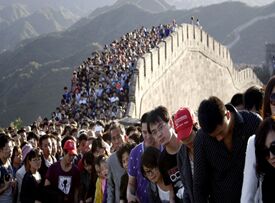"过度旅游"使热门城市面临危机
|
Amsterdam, Venice, Barcelona, Paris – the poster children for overtourism are well-known. Now, 20 more cities are on alert lest they turn into the future face of the problem, according to a new report from the World Travel & Tourism Council and commercial real estate firm JLL. The report, called "Destination 2030", examines the tourism "readiness" of 50 destinations around the world and groups cities into five types. The "emerging performers" category includes destinations where infrastructure and tourism momentum are growing along with the pressures associated with more tourists. Those cities were Bangkok, Cape Town, Ho Chi Minh City, Istanbul, Jakarta, Mexico City and New Delhi.
Another 13 cities – called "mature performers" – were described as having an established tourism infrastructure, strong leisure or business travel, and good positioning to manage current growth levels. "But there is a risk of future strains related to visit volume, infrastructure or activity that is testing readiness for additional growth," the report says. It lists Auckland, Berlin, Dublin, Las Vegas, Lisbon, London, Los Angeles, Madrid, Miami, New York, Seoul, Seville, and Sydney in this category. "Over the past few years … several destinations, and cities in particular, have been criticized in the media for the under-management of travel and tourism and the stresses that visitor numbers have put on urban systems and residents," the report says. Some of the names most synonymous with crowds fell into the "managing momentum" type: Amsterdam, Barcelona, Paris, Prague, Rome, San Francisco, Stockholm, Toronto and Vancouver. Those are described as having established tourism infrastructure and urban readiness but heavy leisure travel volume "with potential to cause strain on the city". "Those cities are the ones that are going to start focusing less on attracting a whole lot of new visitors," says Lauro Ferroni, LL's global head of hotels and hospitality research. Instead, they have to shift their focus to dispersing crowds throughout their city and encouraging visitors to come at off-peak times. Cities listed in two other categories were experiencing somewhat less pressure. "Dawning developers", with an emerging tourism infrastructure, were experiencing gradual tourism growth and lower visitor concentration. Those cities – Bogota, Buenos Aires, Cairo, Chengdu, Kuala Lumpur, Lima, Manila, Moscow, Mumbai, Rio de Janeiro and Riyadh – still have potential to grow, according to the report. The "dawning" and "emerging" cities generally have a less advanced approach to tourism policy, without official positions on regulating home-sharing or specific mentions of tourism in economic plans. "Those are areas we would encourage them to focus on as they become increasingly popular," Ferroni says. The "balanced dynamics" category includes cities with an established infrastructure for visitors, a larger-than-average share of business travelers and room to grow comfortably. They are Beijing, Chicago, Dubai, Hong Kong, Munich, Osaka, Shanghai, Singapore, Tokyo and Washington. The World Tourism Organisation, an agency of the United Nations, said that last year, there were 1.4 billion international tourist arrivals around the world. That total represented a 6 percent increase over the previous year, and arrivals were expected to grow another 3 percent to 4 percent this year. Last year, a European Union report identified 105 destinations in some state of overtourism. And Responsible Travel, a UK-based travel company, put together an overtourism map that includes 98 destinations across 63 countries. Justin Francis, CEO and co-founder of Responsible Travel, says overtourism has only recently become an issue as travel numbers continue to rise. "Very few destinations even have tourism planning, let alone have figured out how to solve the problem," he says. "I think it's a crisis." |









